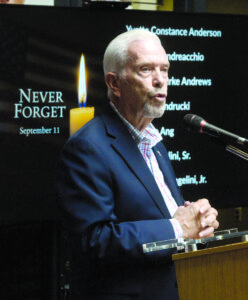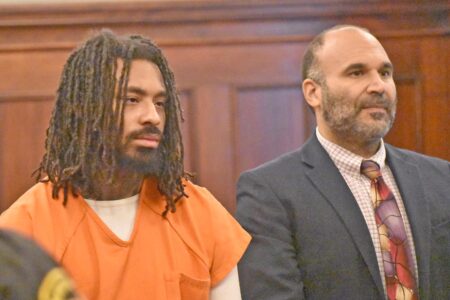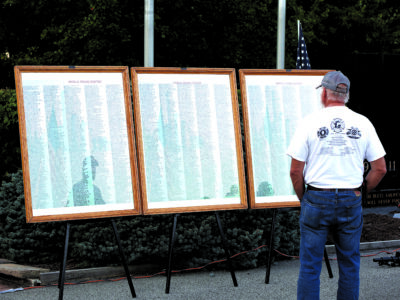Lessons of day heralded at YSU
REMEMBERING SEPT. 11 | 24 years later

Staff photo / R. Michael Semple With the names of 9/11 victims scrolling on a monitor behind him, Youngstown State University President Bill Johnson addresses the audience during the university’s 9/11 observance Thursday.
YOUNGSTOWN — Twenty-four years ago while stationed in South Carolina, Cpl. Derick A. Young had just finished breakfast before dressing in his uniform to testify in a court case when the world as he and nearly everyone else knew it changed dramatically and drastically.
“I got a phone call from someone who said, ‘Are you watching the TV?’ and I said, ‘No,’ and he said, ‘You better turn it on.’ I turned it on and found out like everyone else,” Young, who served in the U.S. Marine Corps from 1998 to 2012, said.
Young, 45, who also is the Mahoning County Veterans Honor Court’s director, shared his early knowledge about the Sept. 11, 2001, terrorist attacks with those who attended a remembrance ceremony Thursday afternoon in Youngstown State University’s Cushwa Hall.
Hosting the somber 45-minute gathering was YSU’s Department of Criminal Justice. Thursday was the 24th anniversary of the terrorist attacks that killed an estimated 2,977 people at the World Trade Center, the Pentagon and in a remote field near Shanksville, Pa.
“Last night 24 years ago, millions of Americans went to bed quietly … and thousands slept with their loved ones one last time,” Young, who also is an adjunct professor in the criminal justice department, said, adding, “Events like 9/11 affect all of us in one way or another, whether we realize it or not.”
The enormity, scope and magnitude of what unfolded in less than two hours that day is one of those epic, far-reaching events in which most people remember in minute detail where they were, who they were with, what they were doing and how they felt when it played out, he explained. For Young, it meant transitioning from peacetime to likely combat in a matter of minutes — something that took its toll, he said.
Unlike nearly everyone else who instinctively ran from the danger in which they had been placed, police officers, firefighters, paramedics and other first responders, knowing they had the support of those they were sworn to serve, risked their safety to rescue others and save countless lives.
In addition, some of them died from the residual effects of 9/11 in the years after the attacks, said Young, who delivered his remarks Thursday while standing between two monitors — one of which captured various harrowing images of the day and the other on which scrolled the names of the fallen.
“Please try to remember at least one name … and that the name has a story, just as you have your own story,” Young told his audience of students and faculty.
Ed Villone, the YSU police academy’s director, recalled that 24 years ago Thursday, he awoke around 7 a.m., then later turned on the “Today” show to see early images that captured a gaping hole in the upper floors of the 110-story World Trade Center’s north tower. He also remembered being skeptical after having seen a large aircraft wheel on the ground nearby, which caused him to think that a small Cessna-type plane would be incapable of inflicting that level of damage on the building.
Soon after, Villone made calls to family members and immediately knew something was amiss, he remembered.
“Evil is lurking all the time, 24/7, and law enforcement is your first line of defense,” he said.
Villone also brought to Thursday’s ceremony Scooby, a 3-year-old Plott hound that was trained as a “stress-related canine counselor” and assists people who have post-traumatic stress disorder, he said.
The tragic events of 9/11 taught some, and reinforced for others, the valuable lesson that “freedom is not free; it comes at a high price. We cannot walk the journey of freedom alone,” YSU President Bill Johnson said in his remarks.
Of the nearly 3,000 people who died in the terrorist attacks, an estimated 2,600 of them were American citizens who woke up that morning to what they assumed would be a normal day, he said, adding that others who were killed represented a total of 90 countries.
The casualties included 343 firefighters with the Fire Department of New York, along with 72 police officers who died in the line of duty, Johnson noted.
Of the 72 fallen officers, 37 of them worked for the Port Authority Police Department, which made it the single deadliest incident for a police department in U.S. history, according to the National Law Enforcement Officers Memorial Fund. Also, hundreds of additional officers have died from a variety of illnesses associated with hazardous and toxic materials at ground zero in the years after the terrorist attacks, the memorial fund site states.
EFFECTS OF 9/11 CONTINUE
Last month, officials with the New York City medical examiner’s office’s missing persons unit announced they had identified the remains of three victims who perished in the attacks at the World Trade Center. The discovery was the latest update in the office’s 24-year effort to identify additional remains, according to a National Public Radio report.
The medical examiner’s office has tested 21,905 remains — everything from bone shards to body fragments to DNA extractions, the report shows.
Thursday’s 9/11-related activities at YSU also included a one-mile remembrance walk that began and ended at Veterans Plaza and was hosted by the Carl A. Nunziato Veterans Resource Center as well as the Andrews Student Recreation and Wellness Center. Also included was a six-hour blood drive in Melnick Hall.
In addition, Young led a discussion about a documentary titled “9/11: I Was There,” which was created in 2021 for the 20th anniversary of the terrorist attacks. The program features rare footage and video from people who shared their perspectives and portrayals of what they saw and filmed that day.




